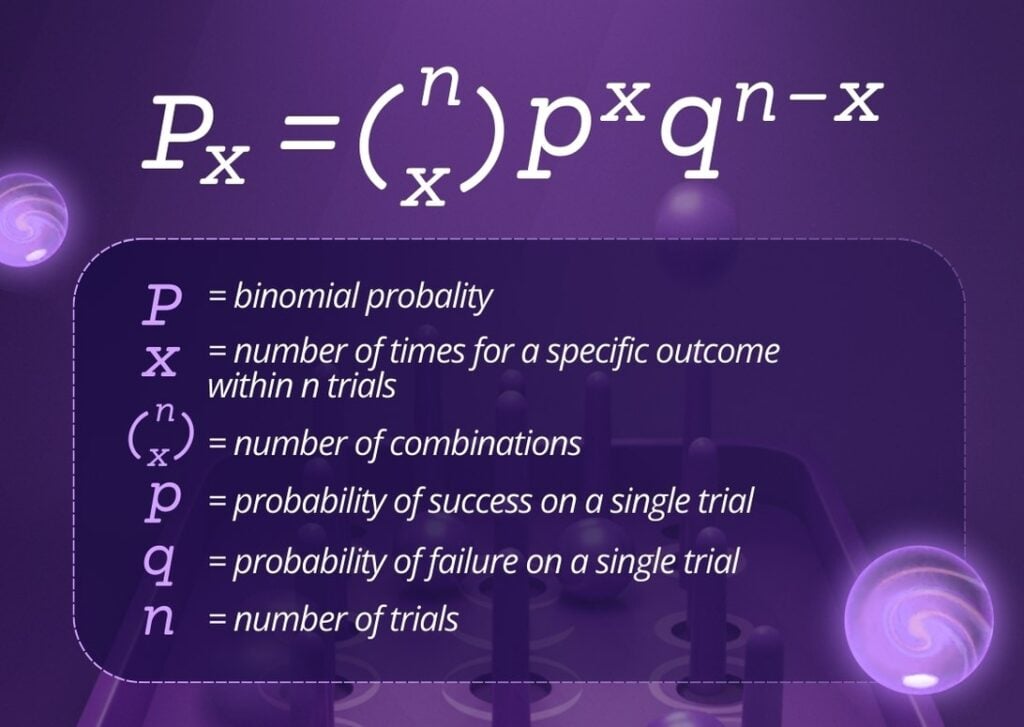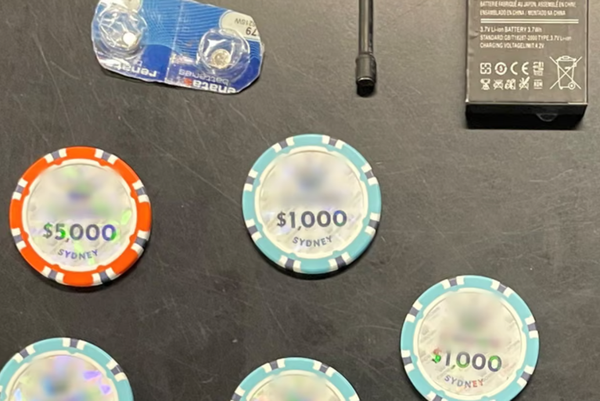
Plinko is a standout among modern casino games, inspired by the TV show format but adapted for digital play. Its rules are pretty simple: a ball drops through a board of pegs and lands in a slot at the bottom, and multipliers tied to each slot decide your return.
Beneath this straightforward look lies a layer of math that dictates how often each slot is hit. Understanding those probabilities can make a noticeable difference in how you approach the game, guiding both your expectations and your bankroll strategy.
This article will walk you through the mechanics of probability and risk in Plinko, and provide a clear guide to help you play smarter.
How Plinko Works
The online Plinko game begins when you release a ball at the top of the board. As it falls, it strikes pegs that send it either left or right. After a series of deflections, it settles into one of the slots at the bottom. Each slot is linked to a multiplier that determines your payout based on the stake you placed before the drop.
At a glance, it may seem like the ball could land anywhere with equal probability. In practice, though, the math favors the middle. Because each peg deflection is essentially a coin toss, most paths lead toward the center slots. The further away from the center, the less likely the ball is to land in those extreme slots. This natural imbalance explains why high multipliers are rarely hit, while low multipliers dominate most results.
Casinos often offer multiple configurations for Plinko boards. You’ll find differences in the number of rows, which affect the spread of probabilities, and in the risk levels, which alter how multipliers are distributed. Learning how Plinko works at this level sets the stage for the deeper analysis that follows.
Binomial Distribution and Slot Probabilities
The math behind Plinko follows a familiar statistical model: the binomial distribution. Every time the ball hits a peg, it has two possible directions, left or right. With N rows, the ball makes N of these binary choices, creating a total of 2^N potential paths. The number of times it moves right determines the final slot at the bottom of the board.
The binomial formula describes the likelihood of each slot:

Example
On a 12-row board:
- Center slot (6 lefts, 6 rights) ≈ 22% probability.
- Adjacent slots (5 rights or 7 rights) ≈ 16% each.
- Edge slots (0 or 12 rights) ≈ 0.02% each.
This binomial distribution Plinko model explains why multipliers are structured the way they are: common center slots pay less, while extreme slots carry huge rewards.
Why Center Hits Dominate and Extremes Are Rare
The dominance of center slots is rooted in variance. With every bounce acting as a 50–50 trial, most paths steer the ball back toward the middle. The result is a bell-shaped distribution where outcomes cluster around the center.
This formula explains why probability clusters in the middle of the board. The center slot corresponds to about half left and half right moves, which has the largest number of possible paths. In contrast, the edge slots can only be reached by one extremely unlikely path — all lefts or all rights.
Extreme multipliers, often found at the edges, demand an improbable sequence of choices. To hit the far-left slot on a 12-row board, the ball must take 12 consecutive left turns. The chance of that happening is 1 in 4,096. The far-right slot carries the same odds. That rarity explains why the payouts at the edges are so high: the game compensates for improbability with extreme multipliers.
For players, this means that Plinko hit frequency is never balanced across the board. Most returns will come from the middle slots, with occasional hits on outer slots to break the pattern. Recognizing this helps adjust expectations: chasing edge multipliers is exciting, but statistically, the majority of your drops will fall closer to the center.
Plinko Rows: 8 vs 12 vs 16
The number of rows in Plinko significantly reshapes the probability distribution. With fewer rows, the spread is tighter, meaning the ball tends to cluster more heavily around the center. As rows increase, the probability distribution widens, and while the center still dominates, the tails become thinner and harder to hit.
Consider three setups:
- 8 Rows: With only 8 decisions, the probability of hitting the edges is higher compared to larger boards. Multipliers may be lower, but the extremes occur more often.
- 12 Rows: The balance shifts. Center slots dominate strongly, and edge outcomes become rare enough that casinos can attach higher multipliers.
- 16 Rows: With 16 coin flips, the chance of hitting the extreme left or right is tiny. This allows casinos to assign huge multipliers to those slots, knowing they will rarely occur.
This change in variance means Plinko rows directly influence risk. Shorter boards create smoother play with less dramatic swings, while longer boards create intense variance with rare but massive multipliers. Players should choose based on their comfort with volatility.
Plinko Risk Levels, Multipliers, and RTP
Every slot in Plinko has a multiplier attached to it. The combination of slot probabilities and multipliers defines the potential odds of the game. Casinos often let players pick between low, medium, and high-risk boards, each reshaping how rewards are distributed.
- Low Risk: Center slots pay close to 1x or slightly above, with edges offering modest boosts. Losses are smaller, but big wins are off the table.
- Medium Risk: Center payouts are reduced, while edges pay higher. Volatility increases, balancing moderate wins with sharper swings.
- High Risk: The center often pays less than 1x, meaning frequent small losses. However, the edge multipliers skyrocket, sometimes offering 100x or more.
Across these setups, the house edge remains steady, often around 1–3%, depending on the provider. That means the long-term RTP stays similar, but the risk profile changes dramatically.
Understanding Plinko risk levels is crucial: a low-risk board stretches your bankroll, while high risk creates short but explosive sessions.
Session Risk: Probability of Busting
A major consideration for Plinko players is the chance of exhausting their bankroll. Busting depends not just on RTP but on variance, unit size, and session length.
For instance, playing 100 units at low risk might stretch across hundreds of drops, since most hits return near break-even. At medium risk, the chance of dipping below zero grows, but streaks of moderate wins can balance losses. In high-risk boards, bankrolls can vanish quickly if edge multipliers aren’t hit within a reasonable number of drops.
This highlights the effect of the Plinko house edge in practice: the math guarantees the casino advantage, but session outcomes vary widely depending on risk level and rows. Players using larger unit sizes relative to their bankroll face higher bust probabilities, while conservative sizing greatly reduces that risk. Understanding this probability helps set realistic session goals and avoid overextending.
Expected Value and Bankroll Implications
Every game of Plinko has a long-term mathematical return known as expected value, or EV.
This number is tied directly to the RTP, which usually sits between 97% and 99% depending on the provider. No matter which risk level or row count you choose, the underlying plinko expected value reflects this house edge.
How Variance Changes Play
Although EV stays consistent through different games in online casinos, variance shifts dramatically across low, medium, and high-risk boards. On low-risk setups, outcomes cluster tightly around break-even, so session swings are relatively modest.
Medium risk spreads the distribution wider, leading to streaks of small losses broken by occasional multipliers. High risk exaggerates this effect, producing frequent shortfalls and the rare possibility of outsized wins.
Bankroll Implications
Because volatility differs so strongly, bankroll planning is critical. Smaller bet sizes relative to total funds help absorb downswings on medium and high-risk modes. Larger unit sizes may be fine on low-risk boards, but on high risk, they can burn through a bankroll quickly.
Understanding how EV interacts with variance makes it easier to choose bet sizes that align with your tolerance for swings and your preferred session length.
Sample Outcomes Chart
Charts make Plinko’s probability structure easier to grasp. A visual breakdown shows how multipliers map to slot frequencies, clarifying the trade-off between frequent small returns and rare large wins.
Take a 12-row medium-risk board as an example. The center slots might pay 0.5x to 1x and capture the majority of results. Outer slots could climb to 9x or 26x, hit only occasionally. The extreme edge may show multipliers of 130x or more, but with hit probabilities in the fraction-of-a-percent range.
A Plinko outcomes chart highlights how these multipliers align with probabilities. For bankroll planning, it becomes clear that the far edges are statistically outliers, while the middle delivers steady but smaller results.
Turning Pegs Into Probabilities
Plinko may look simple, but the game is built on clear mathematics. Each bounce follows predictable probability, shaping outcomes into a distribution where the center dominates and the edges are rare. By understanding how rows, risk settings, and multipliers interact, players can approach the board with realistic expectations.
What changes is not the house advantage but how you manage your session. Choosing smaller units stretches gameplay, while higher risks create sharp swings. The math doesn’t guarantee outcomes, yet it provides a framework for planning bankroll strategy and recognizing what the distribution allows.
Plinko is often presented as pure entertainment, but behind the pegs is a game ruled by numbers. Treating those numbers as part of your approach makes each drop less of a mystery and more of a measured decision.







